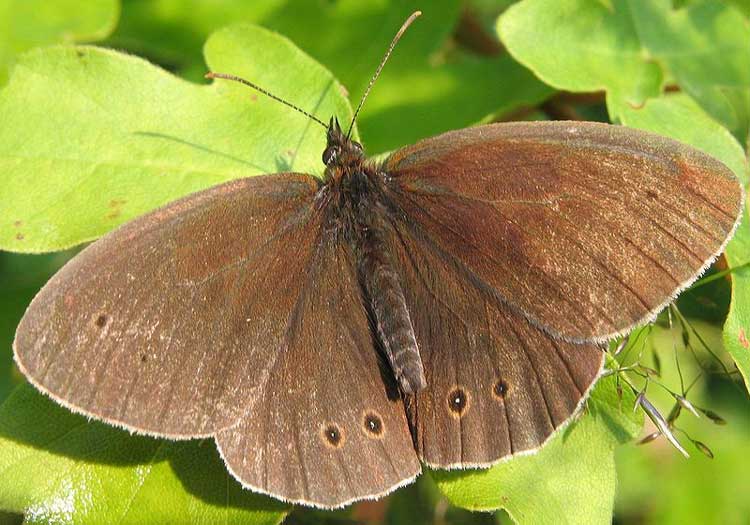
Aphantopus hyperantus (*)
Superregnum: Eukaryota
Cladus: Unikonta
Cladus: Opisthokonta
Cladus: Holozoa
Regnum: Animalia
Subregnum: Eumetazoa
Cladus: Bilateria
Cladus: Nephrozoa
Cladus: Protostomia
Cladus: Ecdysozoa
Cladus: Panarthropoda
Phylum: Arthropoda
Subphylum: Hexapoda
Classis: Insecta
Cladus: Dicondylia
Subclassis: Pterygota
Cladus: Metapterygota
Infraclassis: Neoptera
Cladus: Eumetabola
Cladus: Endopterygota
Superordo: Panorpida
Cladus: Amphiesmenoptera
Ordo: Lepidoptera
Subordo: Glossata
Cladus: Coelolepida
Cladus: Myoglossata
Cladus: Neolepidoptera
Infraordo: Heteroneura
Cladus: Eulepidoptera
Cladus: Ditrysia
Cladus: Apoditrysia
Cladus: Obtectomera
Superfamilia: Papilionoidea
Familia: Nymphalidae
Subfamilia: Satyrinae
Tribus: Satyrini
Subtribus: Maniolina
Genus: Aphantopus
Species: Aphantopus hyperantus
Subspecies: A. h. abaensis – A. h. hyperantus
Name
Aphantopus hyperantus (Linnaeus, 1758)
Synonyms
Basionym: Papilio hyperantus Linnaeus, 1758
References
Primary references
Linnaeus, C. 1758. Systema Naturae per regna tria naturae, secundum classes, ordines, genera, species, cum characteribus, differentiis, synonymis, locis. Editio Decima, Reformata. Tomus I. Holmiæ (Stockholm): impensis direct. Laurentii Salvii. 824 pp. DOI: 10.5962/bhl.title.542 BHL p. 472 BHL Reference page.
Additional references
Yoshino, K., 2003: New butterflies from China 8. Futao 43: 6–20.
Links
Aphantopus hyperantus Taxon details on Fauna Europaea
ZooBank: DAC2DA49-6C59-492D-AACE-CAC5B7F49EE4
Vernacular names
Cymraeg: Gweirlöyn y glaw
dansk: Engrandøje
Deutsch: Brauner Waldvogel
English: Ringlet
suomi: Tesmaperhonen
français: Tristan
Frysk: Donker Sâneachje
hornjoserbsce: Pomróčnica
magyar: Közönséges ökörszemlepke
lietuvių: Tamsusis satyras
Nederlands: Koevinkje
norsk: Gullringvinge
polski: Przestrojnik trawnik
русский: Глазок цветочный
slovenščina: Okati rjavec
svenska: Luktgräsfjäril
Note that information on this species applies to Western Europe and some details may not be consistent with the species in other parts of its range.
The ringlet (Aphantopus hyperantus) is a butterfly in the family Nymphalidae. It is only one of the numerous "ringlet" butterflies in the tribe Satyrini.
Range
The ringlet is a widely distributed species found throughout much of the Palearctic realm. In Europe it is common in most countries but absent from northern Scandinavia, peninsular Italy (found in northern Italy), Portugal, southern and central Spain (found in Cantabrian Mountains and the eastern Pyrenees), the Mediterranean islands and North Africa. In Greece it is found in northern regions (Macedonia, Thessaly). Beyond Europe it is found across much of temperate Asia including Russia, Siberia, Mongolia, China and Korea.
Caterpillar
Description
Aphantopus hyperantus and similar species in Karl Eckstein's Die Schmetterlinge Deutschlands
Aphantopus hyperantus is a medium-sized butterfly with a wingspan of up to 35 to 42 millimeters. The wing upper and lower sides are solid brown with small, yellowish-rimmed eyespots. The newly emerged ringlet has a velvety appearance and is almost black with a white fringe to the wings. The number and size of the eyespots is variable, they may be missing on the upper wing surface. In central Europe and southern England the rare form arete occurs. The eggs are pale yellow when first laid, but become pale brown.
The caterpillars are about 25 millimeters long. They are gray or light reddish brown and have dark, reddish brown and very fine dots. Dorsally there is a dark longitudinal line, which is widened at the segment boundaries. Toward the rear, this line is more intensely colored. The head is darker and has several faint longitudinal stripes.
Subspecies
ssp. abaensis Yoshino, 2003 - northwestern Sichuan
ssp. alpheois Fruhstorfer, 1908 - Ural, western Siberia
ssp. arctica (Seitz, 1909) - northern Europe
ssp. bieti (Oberthür, 1884) - Sichuan and northern Yunnan
ssp. hyperantus Linnaeus, 1758 - western Europe, the type locality is Sweden
ssp. luti Evans, 1915 - southeastern Tibet
ssp. ocellata (Butler, 1882) (= amurensis Staudinger, 1892; = insularis Kurentzov, 1966) - Amur and Ussuri
ssp. sajana (O. Bang-Haas, 1906) - Sayan Mountains
ssp. sibiricus Obraztsov, 1936 - Altai, southern Siberia and Transbaikalia
Habitat
They live in grassy, moist or dry forest clearings with bushes but not in open places. There is a strong degree of attachment to woodland edges and blackberry bushes. The insect can also be very common where there are creeping thistles (Cirsium arvense) or swamp thistles (Cirsium palustre), oregano (Origanum vulgare), forest scabious (Knautia sylvatica), or hogweed (Heracleum sphondylium) which are favorite food plants of the imagos. The males fly in search of newly hatched females in slow, uninterrupted flight and flutter round, about and between grass stems.
Flight period
A single brood butterfly, the imagines fly from mid-June to late August.
Food of the larva
The caterpillars feed on many grasses. Among the food plants are:
Brachypodium sylvaticum
Brachypodium pinnatum
Phleum pratense
Dactylis glomerata
Festuca rubra
Bromus erectus
Bromus hordeaceus
Cynosurus cristatus
Poa pratensis
Poa nemoralis
Carex hirta
Carex strigosa
Carex sylvatic
Carex brizoides
Carex panice
Agrostis capillaris
Lilium effusum
Agropyron repens
Holcus mollis
Holcus lanatus
Deschampsia cespitosa
Molinia caerulea
Arrhenatherum elatius
Calamagrostis epigejos
Development and biology
The female scatters non-adhesive eggs in a slow low flight over grasslands. The larva is nocturnal. There are four moults. The larva hibernates while in the third instar, breaking diapause to feed on warm winter evenings. Feeding resumes in the spring. The pupa stands generally upright in a flimsy silk cocoon, at the base of a grass tussock. This stage lasts for two weeks. A. hyperantus is generally considered to have a closed population structure since it occurs in small, well-defined populations.
Etymology
Hyperantus, of Greek mythology, was one of the 50 sons of Aegyptus, killed by one of the 50 daughters of Danaus.[3]
References
van Swaay, C.; Wynhoff, I.; Verovnik, R.; et al. (2010). "Aphantopus hyperantus". IUCN Red List of Threatened Species. 2010: e.T174327A7051011. Retrieved 1 July 2019.
"Aphantopus hyperantus (Linnaeus, 1758)". Inventaire National du Patrimoine Naturel. Muséum national d’Histoire naturelle. Retrieved 1 July 2019.
Matthew Oates (2015). In Pursuit of Butterflies: A Fifty-year Affair. Bloomsbury Publishing. p. 43. ISBN 978-1-4729-2451-3.
Tom Tolman, Richard Lewington The Butterflies of Europe and Northwest Africa. Nabu-Kosmos, Stuttgart 1998, ISBN 3-440-07573-7 *Heiko Bellmann Der neue Kosmos-Schmetterlingsführer, Schmetterlinge, Raupen und Futterpflanzen. Franckh-Kosmos, Stuttgart 2003ISBN 3-440-09330-1
Günter Ebert, Erwin Rennwald (Hrsg.) Tagfalter. 2. Spezieller Teil: Satyridae, Libytheidae, Lycaenidae, Hesperiidae. In: Die Schmetterlinge Baden-Württembergs. 1. Auflage. Band 2, Ulmer, Stuttgart (Hohenheim) 1991, ISBN 3-8001-3459-4.
Retrieved from "http://en.wikipedia.org/"
All text is available under the terms of the GNU Free Documentation License

